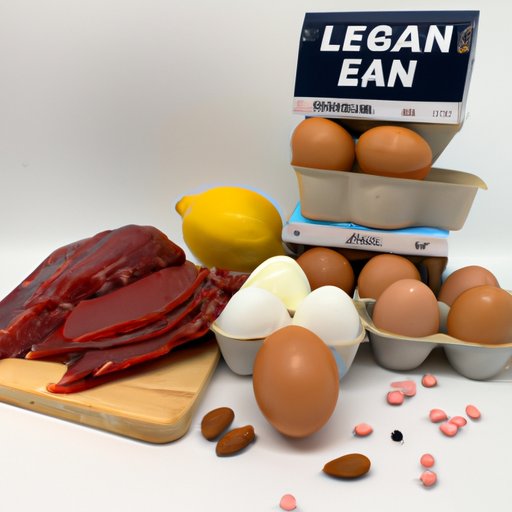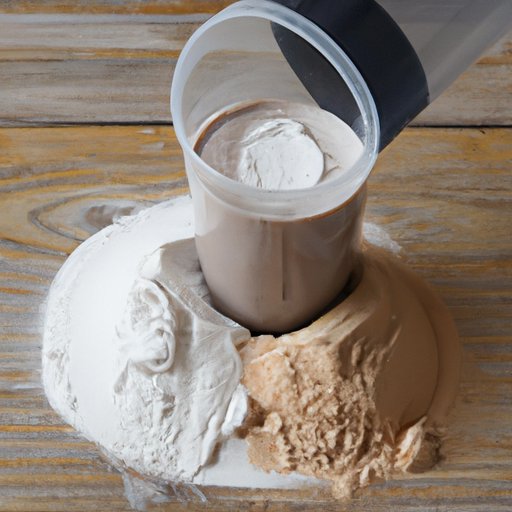Introduction
Protein is an essential macronutrient that plays an important role in nearly every bodily function, from muscle growth and repair to hormone production and metabolism. A balanced diet should include a variety of protein sources to ensure that all of your body’s needs are met. But how do you add more protein to your diet? Here are 8 tips and tricks to help you boost your protein intake in a healthy way.

Incorporate Lean Protein Sources into Meals and Snacks
One of the easiest ways to add more protein to your diet is to incorporate lean protein sources into your meals and snacks. Good sources of lean protein include fish, poultry, eggs, beans, lentils, and low-fat dairy products. These foods are rich in essential amino acids, which are the building blocks of proteins.
For example, you can whip up a quick lunch with grilled chicken, black beans, and roasted vegetables. Or you can make a tasty snack of hard-boiled eggs and avocado slices. Adding lean proteins to your meals and snacks will help keep you feeling full and energized throughout the day.

Add Protein Powder to Smoothies and Shakes
Another great way to get more protein in your diet is to add protein powder to smoothies and shakes. Protein powder comes in a variety of flavors and can be made from a variety of sources, including whey, casein, egg white, plant-based proteins, and even collagen. It’s an easy way to increase the protein content of your favorite smoothie or shake without adding too many extra calories.
When selecting a protein powder, look for one that contains at least 20 grams of protein per serving and has minimal added sugars. You should also choose a product that is free of artificial sweeteners and preservatives. And be sure to read the label carefully — some protein powders contain hidden sources of sugar or other unhealthy ingredients.
Include Nuts and Seeds in Salads, Yogurt, and Cereal
Nuts and seeds are a great source of protein, as well as healthy fats and fiber. Almonds, walnuts, cashews, sunflower seeds, pumpkin seeds, and chia seeds are all excellent options. They can be easily incorporated into salads, yogurt, oatmeal, or cereal for a protein boost.
Nuts and seeds are also a great addition to any meal because they provide heart-healthy fats, vitamin E, magnesium, and other key nutrients. Just be sure to watch your portion sizes — nuts and seeds are high in calories, so it’s best to stick to 1/4 cup or less per serving.
Use High-Protein Flours for Baking
If you’re looking for a healthier alternative to traditional all-purpose flour, try using a high-protein flour instead. High-protein flours, such as almond flour, coconut flour, and chickpea flour, are becoming increasingly popular because they offer more protein and fiber than all-purpose flour. Plus, they have a nutty flavor that adds depth and complexity to baked goods.
When baking with high-protein flours, keep in mind that they tend to absorb more liquid than regular flour, so you may need to adjust the amount of liquid used in the recipe. Additionally, these flours are typically heavier than all-purpose flour, so you may need to add a bit more leavening agent to achieve the desired result.
Replace Refined Grains with Whole Grains
Refined grains, such as white flour and white rice, have been stripped of their bran and germ layers, leaving them with very little nutritional value. On the other hand, whole grains, such as brown rice, oats, barley, and quinoa, retain their bran and germ layers and are packed with vitamins, minerals, and fiber. They are also higher in protein than refined grains.
Swapping out refined grains for whole grains is an easy way to add more protein to your diet. Try replacing white rice with brown rice, white bread with whole-grain bread, and pasta with quinoa or buckwheat noodles. Not only will these swaps add more protein to your meals, but they will also provide additional health benefits.
Try New Protein-Rich Foods like Quinoa, Tofu, and Tempeh
Quinoa, tofu, and tempeh are all excellent sources of plant-based protein. Quinoa is a gluten-free grain that is high in fiber, magnesium, and iron. Tofu is made from soybeans and is a good source of calcium. And tempeh is made from fermented soybeans and is an excellent source of probiotics.
These protein-rich foods can be incorporated into a variety of dishes. Quinoa can be used in place of rice in stir-fries or added to soups and salads. Tofu can be cubed and added to curries or scrambled and used as a vegan substitute for scrambled eggs. And tempeh can be crumbled and added to tacos or stir-fries.
Conclusion
Adding more protein to your diet doesn’t have to be difficult. From incorporating lean protein sources into meals and snacks to trying new protein-rich foods like quinoa, tofu, and tempeh, there are plenty of ways to get the protein your body needs. So experiment with different recipes and find what works best for you! Remember, protein is an important part of a healthy diet, so make sure you’re getting enough.
(Note: Is this article not meeting your expectations? Do you have knowledge or insights to share? Unlock new opportunities and expand your reach by joining our authors team. Click Registration to join us and share your expertise with our readers.)
